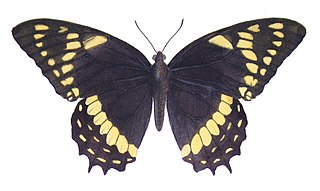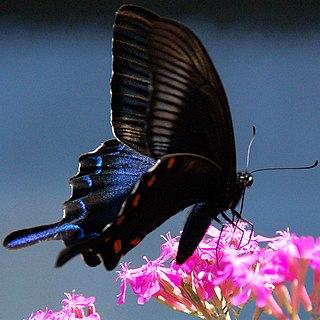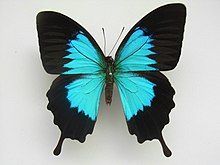
Papilio is a genus in the swallowtail butterfly family, Papilionidae, as well as the only representative of the tribe Papilionini. The word papilio is Latin for butterfly.

Papilio palinurus, the emerald swallowtail, emerald peacock, or green-banded peacock, is a butterfly of the genus Papilio of the family Papilionidae. It is native to Southeast Asia, but is regularly kept in butterfly houses around the world.

Papilio paris, the Paris peacock(Myanmar name: ဒေါင်းစိမ်းလိပ်ပြာ), is a species of swallowtail butterfly found in the Indian subcontinent and southeast Asia.

Papilio elephenor, the yellow-crested spangle, is a species of swallowtail butterfly found in Northeast India. Following decades without confirmed sightings, it was rediscovered in 2009 in Assam.

Papilio buddha, the Malabar banded peacock, is a species of swallowtail butterfly found in the Western Ghats of India. The Government of Kerala declared it as the official Kerala state butterfly.

Papilio aegeus, the orchard swallowtail butterfly or large citrus butterfly is a species of butterfly from the family Papilionidae, that is found in eastern Australia and Papua New Guinea.

Papilio chikae, the Luzon peacock swallowtail, is a species of butterfly in the family Papilionidae. It is endemic to the Philippines. It has two subspecies, with P. c. chikae from Luzon and P. c. hermeli(Nuyda, 1992) from Mindoro. The latter was originally described as a separate species, but it resembles the nominate subspecies and there are no significant differences in their genitalia, leading recent authorities to treat them as subspecies of a single species.

Papilio maackii, the alpine black swallowtail, is a butterfly of the family Papilionidae. It is found in Central Asia, Japan, China and South Korea.

Papilio dialis, the southern Chinese peacock, is a swallowtail butterfly, native to China, Hainan, Taiwan and Burma

Papilio thoas, the king swallowtail or Thoas swallowtail, is a butterfly of the family Papilionidae. It is found in the southernmost United States, Mexico, Central America and South America. The species is easily confused with the giant swallowtail, which it closely resembles in both larval and adult stages. The caterpillars feed on the leaves of citrus plants (Rutaceae). They have also been reported as feeding on a member of the genus Piper.

Papilio blumei, the peacock or green swallowtail, is a butterfly of the family Papilionidae. It is found only on the Indonesian island of Sulawesi. It is sometimes confused with the more widespread P. palinurus, but that species is smaller and has mostly black tails.

Papilio peranthus is a butterfly of the family Papilionidae. It is found in Indonesia.

Papilio anchisiades, the ruby-spotted swallowtail or red-spotted swallowtail, is a butterfly of the family Papilionidae. It is found from southern Texas south to Argentina. Rare strays can be found up to Kansas, southeastern Arizona, and western Texas.

Papilio menatius is a butterfly of the family Papilionidae.

Papilio lorquinianus, the sea green swallowtail, is a butterfly of the family Papilionidae. It is found in the Moluccas and in western Irian Jaya.

Papilio doddsi is a species of swallowtail butterfly from the genus Papilio that is found in Vietnam.

Papilio karna is a species of swallowtail butterfly from the genus Papilio that is found in Java, Sumatra, Borneo and the Philippines.

Papilio montrouzieri, occasionally referred to as Montrouzier's Ulysses, is a species of swallowtail butterfly from the genus Papilio that is endemic to New Caledonia. It resembles the more widespread relative, Papilio ulysses. Its name refers to French entomologist, explorer and priest Xavier Montrouzier.

Parides phaleucas is a species of butterfly in the family Papilionidae. It was described by William Chapman Hewitson in 1869. It is found in Ecuador and Peru.

Achillides, the peacock swallowtails, are a subgenus within the genus Papilio containing 25 species.






















